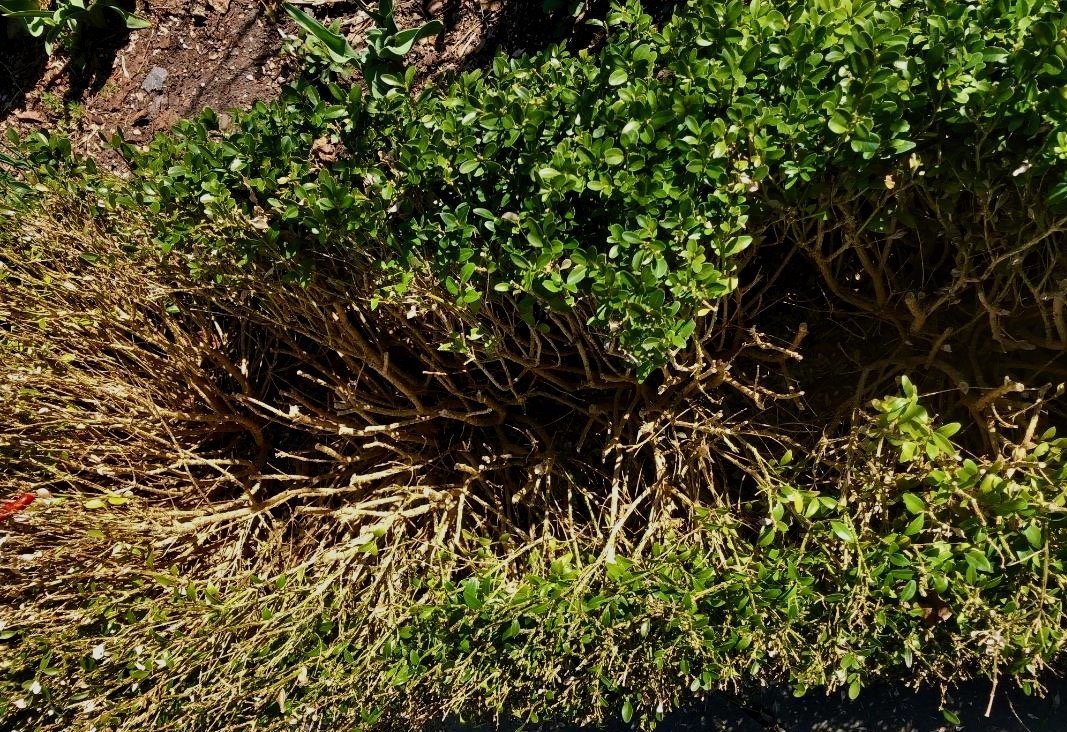Boxwoods looking stressed? Check them out for boxwood blight
All is not sweetness and light in my garden this spring. Boxwood blight has crept into the four hedges of Boxwood sempervirens ‘North Star’ that outline my front beds. These were supposedly not susceptible and for the past ten years have have performed beautifully. Until the end of last summer, I thought they were bulletproof. At first they just looked mildly stressed, like many other things at the end of the season.
Blight is really hard to diagnose - at first it looks like it could be a number of things. Maybe my story will be helpful to some of you.
Here are a few key facts about boxwood blight: (taken from Cornell CooperativeExtension site)
A disease caused by the fungus Calonectriapseudonaviculata..
Can cause leaf spots, twig lesions, shedding of foliage and death of the infected plant.
The fungus can begin to produce infectious spores in a matter of days after symptoms first develop.
Spores are easily spread to other nearby boxwood so quick identification of the pathogen is essential in limiting the spread of the fungus.
In the photo below, the problem is just beginning - you can see a small browned out area on the hedge on the left side and the one in the foreground looks slightly yellow. As noted above, it’s very infectious and spreads quickly. I wish I had gotten on it earlier.
I’ll confess - I was in denial. I put their demise down to dry conditions, leaf burn, maybe a case of boxwood leaf miner, but nope - on close inspection, no evidence of any eggs in the leaves. Couldn’t find any mites either.
It kept getting worse as fall and winter marched on and I got a little desperate. After consulting the Cornell Cooperative Extension site for further information and checking photos here on how to identify blight, I had to admit that the hedges were afflicted. It begins with the dark spot on the leaf (above photo) and progresses from brown to dead.
Dark stem lesions are another symptom to look for.
You can see how it spread over the winter in the photo below. The damage (so far) is limited to the front two segments of hedging.
Here’s what I did: (Inspired by guidelines I read about in RHS gardening)
Get the right tools: Armed with the shop vac, pruning equipment and disinfecting wipes, I pruned out the diseased wood.
2. Prune and disinfect: I had two goals - to eliminate the infected wood and open the shrub up to promote air circulation and new growth. Most of the damage was at the center of the shrub, I considered it hopeful to see new leaves emerging from inside. Because the spores are so infectious, I disinfected my hand pruners with Clorox wipes as I cut so I wouldn’t spread it. I used my hand pruners to cut the top of the hedge because I didn’t want them falling all over the place. Every time I cut, I held the clippings in my hand and dumped them into a plastic trug that I emptied into a heavy duty trash bag. I used a pair of sharp hedge clippers along the sides and cleaned up as I went. I detected minor damage in the other two hedges and pruned it the same way but less extreme.
3. Clean up: I combed through the foliage every time I cut to insure nothing was left behind. When I was finished I used the shop vac to suck up the dead leaves and other debris. Underneath each shrub I found significant accumulations of previous years boxwood leaves. I couldn’t get them with the shop vac so removed them by hand.
4. Fertilization: Boxwood put on most of their growth in spring and summer. I fed mine with Plantone, an all purpose organic granular fertilizer.
5. Management: There is no cure for boxwood blight, only good management. I might dig out a few of the badly infected shrubs and will prune the others back harder after new growth emerges. I guess I’m going to break down and spray. Just found an organic copper fungicide that’s recommended to retard the spread.
The whole business is very infectious - I washed my shoes and clothes and disinfected the tools at the end of the day so I wouldn’t spread it anywhere else. I won’t lie, this was a labor of love that took up the whole day! Afterwards, I was too tired to even think about cleaning the house or car ( I could grow seedlings in the back seat) but damn, the garden is immaculate! Here’s hoping for the best outcome. Would love to hear from any of you who have had experience with this problem.







